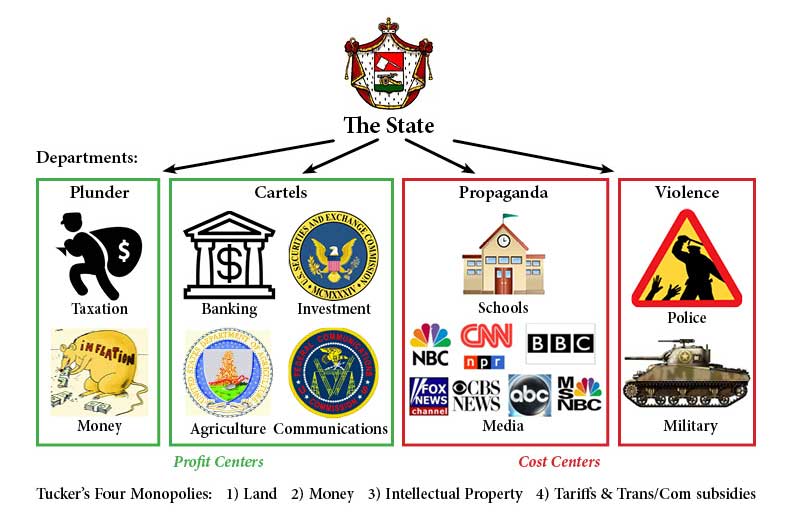The following quotes are from Foster Gamble, a notable proponent of the GDA conspiracy theory. Unquoted comments are by me, Hogeye Bill.
Global Domination Elites - “a small group of financial elite have gained control over key areas of our lives – energy, food, health care, education and more – and are the single greatest threat to humanity’s ability to thrive.”
“We’ve been duped into a system that is designed to consolidate wealth and power, rather than provide a real opportunity for people to thrive.”
On this point, anarchists and conspiracy theorists agree entirely. The disagreement is about whether the system is ultimately run by rulers or by by a banking “cabal” exterior to the State - that is, by political elites or an independent group of economic elites.
“The desperate drive to dominate others is based in a worldview of scarcity and fear.”
I disagree. I think the motivation to dominate others is based on the fact that it can be easier to gain wealth by plunder than by production. The dominators are the plundering parasitical class, as opposed to the productive class. The dominance could be perpetrated by either fear and punishment as in 1984, or mind-numbing pleasures and rewards as in Brave New World. Generally both carrot and stick are used, with the carrot being the more economic option. Propaganda and indoctrination are cheaper than police and prisons.
“The global domination agenda is a plan by powerful private bankers to take over all our primary systems (money, energy, food, media, etc.) and to establish a sole global authority – with themselves in charge.”
I disagree with this banker-centered model. The rulers of States have the bulk of the violence-power, and create the fiat money. Corporatist bankers are merely buying cartel enforcement services from the various State rulers. States arrest and dispossess and crush bankers at will; the bankers are clearly dependent on the violence-power of governments. Foster Gamble has it completely wrong about who is at the top of the pyramid of political power. It is States - ruling elites - that are at the top of the pyramid. It is government rulers who control the bankers, in the sense of being the entity that sells the banking elites the violence-power which maintains their privileged position. We might call Foster Gamble’s model the “bankster conspiracy model,” and the anarchist model I hold the “anti-state model.” The anti-state model is this:
In this model, the banksters (crony bankers, i.e. members of government-enforced banking cartels) are just another government controlled industry, run by a government cartel enforcement (“regulatory”) agency. This view does not deny that banksters would like to run the world, and aspire to gain more power from rulers, and have international organizations and common concerns. The anti-state model simply points out that all these activities are done within a statist paradigm, where States have the violence power (weapons) and banksters must beg or buy favors from rulers to survive and thrive through legal plunder rather than honest production.
Putting a conspiracy of bankers at the top of the pyramid would be like looking at the world before 1800 when slavery was legal and common, and claiming that slavers ran the world rather than kings and other rulers. In fact, slavers thrived because statist legal systems protected the practice through violence. Just like today’s bankers, slavers had associations and meetings and conspired to gain more government suck through bribery and lobbying and such. To claim that slavers were at the top of the pyramid back then would be inaccurate and misleading. Slavers had political suck back then, just as banksters do now. So the conspiracy model fails, but the anti-state model holds - since the slavery cartel was enforced by State through the enforcement of Fugitive Slave Laws and other decrees. Slavery was just another item in the cartel box back then, as corporatized banking is today.
The anti-state model rests on the realization that in a freed market (a market with no State intervention whatsoever) cartels and conspiracies are doomed to failure. It takes the introduction of force - aggression of some type - to make a cartel feasible. This is not to say that cartels are impossible in a free market; only that there are major forces, primarily competition, which make such cartels unstable and unsustainable. It is hard to find a single example of a successful long-term cartel that was not dependent on government violence-power. The early US railroads failed to maintain a cartel, until they lobbied the State to create a cartel-enforcement agency called the ICC, Interstate Commerce Commission. Big agricultural interests failed to create a cartel until they lobbied for an Agriculture Department. The banksters scored their big win with the creation of the Federal Reserve System in 1913. Once one realizes that so-called regulatory agencies are really cartel enforcement agencies, the anti-state model becomes obvious. Corporatist bankers certainly benefit from the State, and collude with the State, but are clearly subordinate to the State and its rulers.
The bankster conspiracy model is not convincing to me, and would seem to detract from understanding how power and political authority really work. Statism is a wicked problem - not a tame problem that can be solved simply by eliminating a few evil conspirators. Anarchists see the problem as one of inadequate institutions maintained by perverse incentives - the State supported by that most dangerous superstition of political authority: the right of rulers to rule and duty of everyone else to obey. Dispelling this superstition in the minds of men is a difficult problem to solve, and requires ongoing effort. It is naïve to think that getting rid of certain secret societies of conspirators will solve everything. Building alternative institutions is harder than witch-hunting, but more effective.
Resources
Opportunities for Counter-institutionsWhat Can I Do?
New Libertarian Manifesto
Hogeye Bill's Anarchism Page


